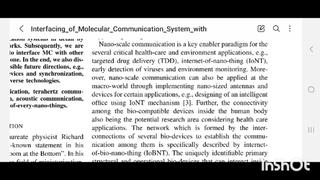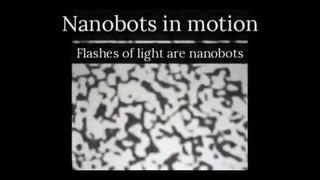He's into Meshtastic too it seems
Could prove very useful, methinks in the not too distant future.
ARMBIO VICTIMS HAVE VERY COMPLEX STRUCTURES SUGGESTIVE OF LIFE | LQC
https://www.bitchute.com/video/pehKCXbypz0x/
It turns out that ArmBio victims have very complex structures suggestive of life. A team of EXPERT BIOLOGISTS is aware of this situation, and they already declared informally that these structures HAVE NOT BEEN CLASSIFIED BEFORE, their collaboration is very important to clarify the truth of what today is murdering our humanity. WE MUST MAKE ALLIANCES WITH PROFESSIONALS FROM DIFFERENT FIELDS TO SAVE MORE LIVES...!
Source: La Quinta Columna.
5G CONTROL OF HUMANITY AND MORE - LA QUINTA COLUMNA'S RICARDO DELGADO JOINS WITH DAVID ICKE
La Quinta Columna's Ricardo Delgado, Astrid Stuckelberger and José Luis Sevillano join David Icke. The team that identified graphene in the fake vaccine. Aired 16 January 2024.
What is reported in the interview between these four people is right out of a horror movie, except it is reported as non-fiction. An informative report overall that succeeds at connecting the dots.
We Are Being Warned That Nanobots Will Be Flowing Through Our Bodies “By 2030” And Will Be Used To Connect Our Brains To The Internet
Once thousands of nanobots are zipping around inside your body, will you still be in control of your mind, will and emotions or will the nanobots be running the show? According to Google, a nanobot is “a hypothetical, very small, self-propelled machine, especially one that has some degree of autonomy and can reproduce”. Scientists here in the United States have been working on nanobots that can travel through our bodies at astonishing speeds, deliver medicines to targeted locations, and even enter our brain cells. Eventually, researchers hope to use nanobots to connect our brains directly to the Internet. I realize that all of this sounds quite crazy, but as you will see below, everything that I am sharing with you has been documented.
Some experts even believe that someday nanobots will actually be capable of enabling humans to live indefinitely. The following comes from an article entitled “Nanobots Will Be Flowing Through Your Body by 2030”…
Futurists often claim that nanobots hold the key to eternal life. Inventor, author, and Google futurist Ray Kurzweil, in an interview with Neil deGrasse, claimed that tiny nanobots in our bloodstreams will prevent us from dying in 2030. According to Kurzweil, the nanobots will travel inside you on a molecular level, protecting your biological system and ensuring you’ll have a good and long life. The future is closer than you may think!
I certainly don’t want nanobots “flowing through my body” by 2030.
But this is the future that they have planned for us.
In Colorado, one team of scientists has already developed nanobots that can travel through human bodies “at incredible speeds”…
Wyatt Shields, IV, PhD, Chemical & Biological Engineer at University of Colorado, Boulder says, “Medical microrobots are, essentially, microscale devices. So, we’re talking devices five to 10 times thinner than the human hair.”
A team of engineers at the University of Colorado, Boulder has designed a new class of tiny, self-propelled robots that can zip through a body at incredible speeds. The bots are made out of polymer materials that are biocompatible using a technology similar to 3D printing. They look like small rockets with three tiny fins.
“And the result is that these robots move really fast. So, on the order of several hundred body lengths per second, I think 120 or 140 body lengths per second. So, that would be equivalent to a six-foot-tall person running 400 miles per hour,” adds Professor Shields.
Researchers envision a day when thousands of nanobots are zipping around inside our bodies performing various tasks.
For example, one company in California has actually been working on nanobots that are “designed to transport medication to the exact location in the body where it’s needed”…
California-based startup Bionaut Labs has developed a nanobot about the size of a grain of rice that’s designed to transport medication to the exact location in the body where it’s needed. If you think about it, the conventional way to deliver medicine makes little sense: A painkiller affects the entire body instead of just the arm that’s hurting, and chemotherapy is flushed through all the veins instead of precisely targeting the tumor.
To a lot of people, such technology is going to sound absolutely wonderful.
In particular, Bionaut Labs is very excited about the possibility of using their nanobots to attack tumors…
Several startups and academic institutes worldwide are working to develop such a solution but Bionaut Labs seems the furthest along in advancing its invention. “You can think of the Bionaut as a tiny screw that moves through the veins as if steered by an invisible screwdriver until it arrives at the tumor,” Shpigelmacher explains. Via Zoom, he shares the screen of an X-ray machine in his Culver City lab to demonstrate how the half-transparent, yellowish device winds its way along the spine in the body. The nanobot contains a tiny but powerful magnet. The “invisible screwdriver” is an external magnetic field that rotates that magnet inside the device and gets it to move and change directions.
That definitely sounds very impressive.
But what are the dangers?
Many are concerned that someday nanobot technology could potentially be used to completely enslave humanity.
Even now, scientists are developing nanobots that can actually go inside cells and transmit information to the outside world. The following comes from an article entitled “Nanobots can now enter brain cells to spy on what they’re doing”…
Deblina Sarkar has big dreams for the little machines that she makes. Some of her ultra-tiny electronic devices are smaller than a mote of dust. And her dreams? They’re so big that they may one day be able to save your mind.
Sarkar is an MIT scientist that is trying to use nanotechnology to help those with Alzheimer’s disease and Parkinson’s disease.
Her team has created something called a “Cell Rover” that has entered a frog-egg cell and successfully transmitted a signal from inside…
Her group’s most innovative device may be the Cell Rover. A tiny, flat antenna, this rover can transmit a signal from inside of a cell — without harming it.
In one study last year, Sarkar and her colleagues placed a Cell Rover into a frog-egg cell. Using magnetic fields, they gently nudged the device into the egg. Once it was safely inside, the researchers activated a different magnetic field. That caused molecules in the nanodevice to vibrate.
Those vibrations didn’t hurt the cell. They just changed the magnetic field of the Cell Rover itself. A receiver outside the egg detected the altered magnetic field of the quivering rover. In this way, the device had been able to communicate with the outside world.
But this is just the beginning of what these researchers hope to accomplish.
Eventually, Sarkar intends to “insert nanodevices between human neurons” in order to make our brains even faster than they currently are…
Eventually, Sarkar hopes to insert nanodevices between human neurons. That could boost our mind’s computing speed. Our brains are remarkable, she says, but adds “we could be better than what we are.”
Needless to say, it won’t stop there.
Ray Kurzweil is looking forward to the day when nanobots will “provide virtual and augmented reality from within the nervous system” and will enable allow our brains to connect directly to the Internet…
One thesis of mine is that we’re going to merge with the intelligent technology that we are creating. The scenario that I have is that we will send medical nanorobots into our bloodstream. One application of these medical nanorobots will be to extend our immune systems. That’s what I call the third bridge to radical life extension. The first bridge is what we can do now, and bridge two is the perfecting of biotechnology and reprogramming the software of life. Bridge three constitutes these medical nanorobots to perfect the immune system. These robots will also go into the brain and provide virtual and augmented reality from within the nervous system rather than from devices attached to the outside of our bodies. The most important application of the medical nanorobots is that we will connect the top layers of our neocortex to synthetic neocortex in the cloud.
What would our world look like if most of our brains were directly connected to the Internet by nanobots?
To me, the potential for tyranny would be off the charts.
A central authority with power over those nanobots could wield a tremendous amount of power over our thoughts, feelings and core beliefs.
So I will never willingly allow anyone to put any nanobots inside of me.
But one of the things that is so frightening about nanobots is that they are so small that they could potentially enter your body without you even noticing.
And once they are running around inside of you, getting them out is not going to be easy at all.
" The vaccine samples were likely degraded"
Do you have proof of this? Like microscope photos, of degraded samples. "Likely" isn't very scientific you know. It sounds good though to put people off investigating further who may want the vaccines to be "safe and effective"
I agree with him on the magnification though, not much else.
For the sake of a fair argument, the vaccines could have been degraded (as in contaminated) and some of the "structures" visualized could have been contaminants, but even so, if degraded as explained, it still does not negate the possibility of genetically-engineered bacterium in the sterile solution. So, the argument that the vials may have been degraded / contaminated does not disprove that there are nanoparticles in the original solutions which there appears there are. La Quinta Columna used an electron microscope and showed the progression of a growing structure, i.e. parasite or toxic gmo bacterium.
Real-Time Self-Assembly of Stereomicroscopically Visible Artificial Constructions in Incubated Specimens of mRNA Products Mainly from Pfizer and Moderna: A Comprehensive Longitudinal Study
https://mail.ijvtpr.com/index.php/IJVTPR/article/view/102
Observable real-time injuries at the cellular level in recipients of the “safe and effective” COVID-19 injectables are documented here for the first time with the presentation of a comprehensive description and analysis of observed phenomena. The global administration of these often-mandated products from late 2020 triggered a plethora of independent research studies of the modified RNA injectable gene therapies, most notably those manufactured by Pfizer and Moderna. Analyses reported here consist of precise laboratory “bench science” aiming to understand why serious debilitating, prolonged injuries (and many deaths) occurred increasingly without any measurable protective effect from the aggressively, marketed products. The contents of COVID-19 injectables were examined under a stereomicroscope at up to 400X magnification. Carefully preserved specimens were cultured in a range of distinct media to observe immediate and long-term cause-and-effect relationships between the injectables and living cells under carefully controlled conditions. From such research, reasonable inferences can be drawn about observed injuries worldwide that have occurred since the injectables were pressed upon billions of individuals. In addition to cellular toxicity, our findings reveal numerous — on the order of 3~4 x 106 per milliliter of the injectable — visible artificial self-assembling entities ranging from about 1 to 100 µm, or greater, of many different shapes. There were animated worm-like entities, discs, chains, spirals, tubes, right-angle structures containing other artificial entities within them, and so forth. All these are exceedingly beyond any expected and acceptable levels of contamination of the COVID-19 injectables, and incubation studies revealed the progressive self-assembly of many artifactual structures. As time progressed during incubation, simple one- and two-dimensional structures over two or three weeks became more complex in shape and size developing into stereoscopically visible entities in three-dimensions. They resembled carbon nanotube filaments, ribbons, and tapes, some appearing as transparent, thin, flat membranes, and others as three-dimensional spirals, and beaded chains. Some of these seemed to appear and then disappear over time. Our observations suggest the presence of some kind of nanotechnology in the COVID-19 injectables.
Ex Australian MP - Death Threats if he exposed self-assembling structures - (Nov 2022)
Ex Australian MP - Death Threats if he exposed self-assembling structures -...
A brief history of nanotechnology
In this article we explore the history of nanotechnology and provide resources to show that self-assembling nanotechnology as a medical application is real and happening right now.
Sep 11, 2024
X has been blowing up this week with the freedom crowd working overtime to discredit a peer-reviewed study claiming to have found “self-assembling nanotechnology in 54 vials of covid-19 vaccines” You can view that paper here: A brief history of nanotechnology

Nanotech in vaccines: fact or fiction?
Dr. Wilfredo Stokes: Nanotech Mutation of Humanity | The Freedom Articles
Guatemalan surgeon and scientific researcher Dr. Wilfredo Stokes exposes the full scope of the NWO mind control agenda via nanotech. He describes it as a mutation of the human species. See blood under microscopic slides with flashing nanobots, luminscent bubbles, polycrystalline self-assembling structures in the blood, black goo and a form of "red" black goo. The nanotech is activated by EMF (like 5G) from mobile phone antennas. - MF.
NATO paper says nanotechnology can be used to link human brain to a computer, David A. Hughes




